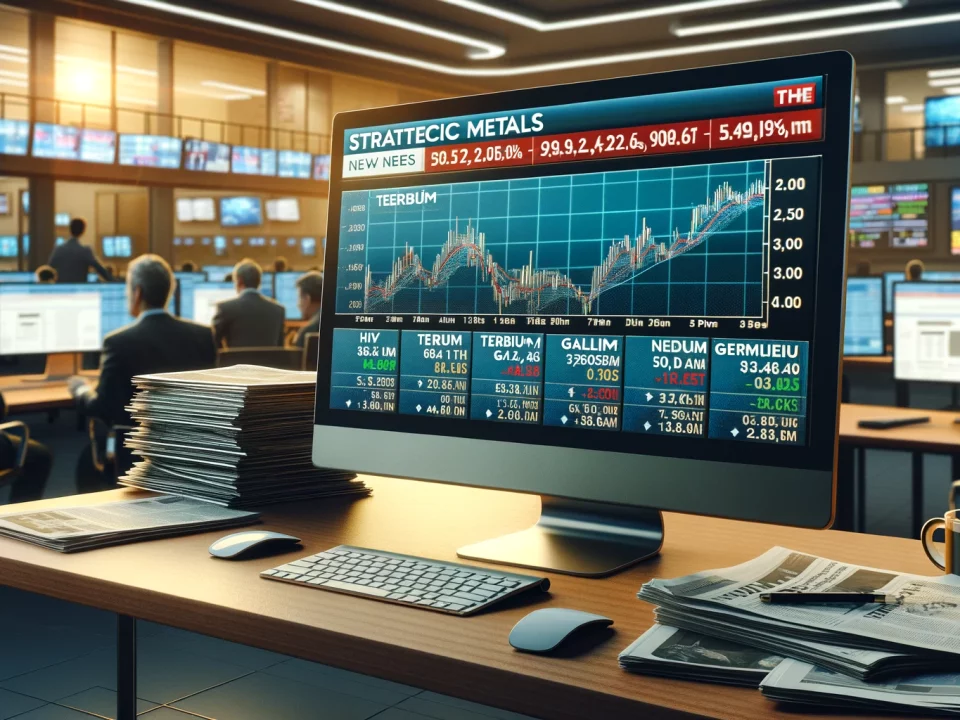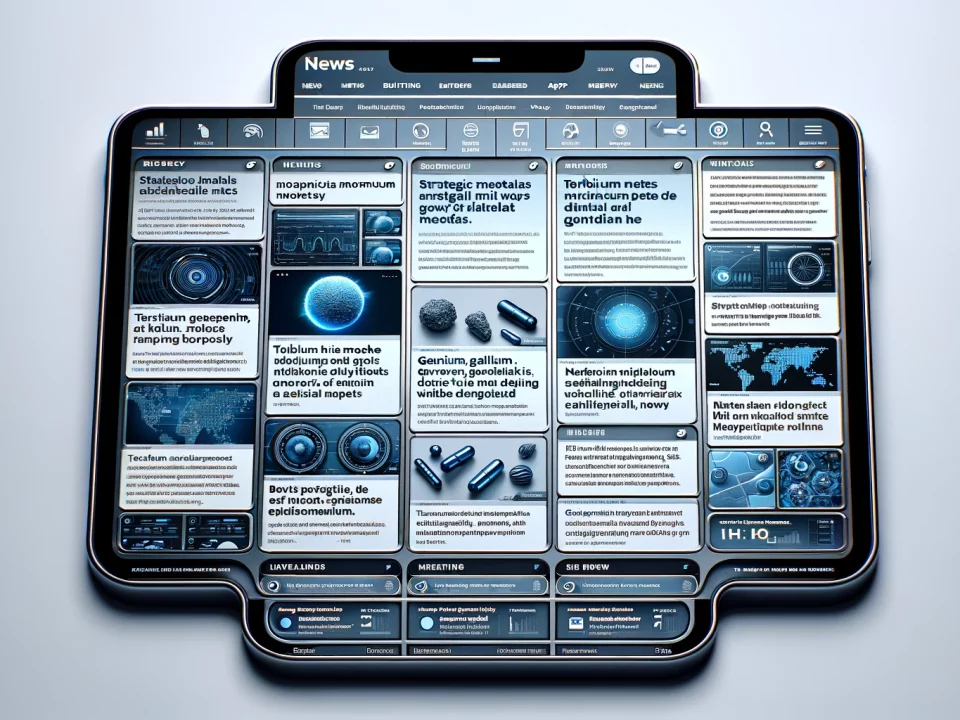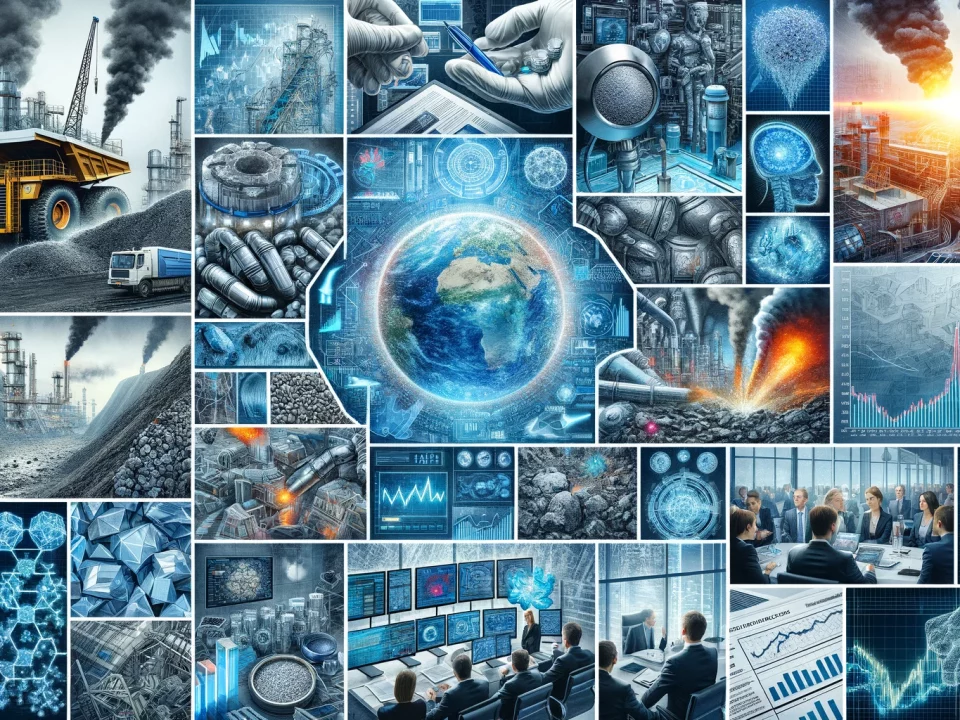
Weekly News Review August 18 – August 24 2025
August 24, 2025
Dysprosium Sep 2025 Price Update: From $353 to $780/kg in 8 Months
September 4, 2025This week, the U.S. Geological Survey released its draft 2025 Critical Minerals List, adding six commodities, including silver and copper. Meanwhile, rare earths producer Lynas announced an equity raise to expand its processing capacity amid ongoing uncertainty surrounding its Texas project. Meanwhile, Germany and Canada plan to deepen cooperation on refining and recycling technologies.
All this and more from the newsroom.
USGS PUBLISHES DRAFT 2025 CRITICAL MINERALS LIST:
New additions to the list are potash, silicon, copper, silver, rhenium, and lead—arsenic and tellurium to be removed.
The U.S. Geological Survey (USGS) has released its draft 2025 List of Critical Minerals, which will guide future U.S. strategy, investment, and permitting decisions in the domestic sector. The draft identifies 54 mineral commodities, including six new additions: potash, silicon, copper, silver, rhenium, and lead. At the same time, arsenic and tellurium have been removed.
Both arsenic and tellurium were included on the 2022 list, but supply chain dynamics have since shifted. According to the USGS, a major copper operation in Utah has increased its copper telluride recovery capacity, enabling the U.S. to transition from being a net importer to a net exporter of tellurium. Arsenic’s global production has also realigned, with Peru overtaking China as the leading source.
Click Here to find and read the full report in our expert publications section.
Agency Also Outlines the Impacts of Supply Disruptions to the U.S. Economy:
Alongside the draft list, the USGS published a report presenting a new supply chain disruption model that quantifies potential impacts on the U.S. economy. “Minerals-based industries contributed over $4 trillion to the U.S. economy in 2024, and with this methodology, we can pinpoint which industries may feel the greatest impacts of supply disruptions,” said Sarah Ryker, acting director of USGS.
The report identifies the top 10 minerals by probability-weighted economic risk from supply disruptions: samarium, rhodium, lutetium, terbium, dysprosium, gallium, germanium, gadolinium, tungsten, and niobium. Except for niobium, which is dominated by Brazil, and rhodium, which is sourced mainly from South Africa’s platinum sector, production of these elements is overwhelmingly concentrated in China. Given Beijing’s repeated expansion of its list of goods subject to export controls in recent years, which have curbed shipments abroad, this dependency poses heightened risks for U.S. industries reliant on secure mineral supplies.
However, the impact of a rhodium supply disruption from South Africa is among the largest: the USGS projects a $64 billion drop in U.S. GDP should shipments cease entirely, though probability weighting reduces the expected impact to $2.5 billion.
Experts say the draft highlights both economic and strategic considerations. Philipp Götzl-Mamba, precious metals trader at German raw materials firm Tradium, commented, “It comes as no surprise that silver is now on the U.S. list of critical minerals, while the criticality of rhodium becomes increasingly relevant. Both metals are indispensable for key technologies, and their inclusion underscores their strategic importance. At the same time, the list sends a clear political signal: Washington recognizes its dependence and is taking steps to address it.”
JAPAN EYES MINING INVESTMENT AND POTENTIAL IN NIGERIA:
Partnership could boost local value creation in the African nation while strengthening Japan’s supply of critical raw materials.
Africa is rich in critical minerals essential for the global energy transition, digitalization, and even defense technology. Yet, experts say much of this resource wealth remains untapped or underutilized. Even where mining takes place, local value creation is usually limited, although processed products would generate significantly higher revenues.
Instead, most raw materials are shipped abroad for processing, primarily to China. For decades, Beijing has secured access to Africa’s mineral wealth through trade agreements and infrastructure projects. Increasingly, however, Western countries are trying to position themselves as alternative partners to diversify their own raw material supply chains.
Last week, Nigeria and Japan reportedly agreed to closer cooperation in the field of critical minerals. The deal followed talks between Dr. Dele Alake, Nigeria’s Minister of Solid Minerals Development, and Michio Daito, President of JOGMEC, Japan’s state-owned organization for securing metal and energy supplies, which finances mineral exploration and extraction both domestically and abroad. The meeting took place during the ninth Tokyo International Conference on African Development (TICAD9) in Yokohama.
Nigeria’s Mining Sector: High Potential, Chronic Underinvestment:
According to Alake, Nigeria is ready to help meet Japan’s demand for processed raw materials. He encouraged JOGMEC to invest in local extraction and processing, and hinted that Japanese companies could benefit from exemptions on import duties for mining equipment as well as tax incentives. The specific terms of cooperation are now to be reviewed by both governments.
Nigeria, once a major exporter of tin, lead, and coal, is believed to hold largely untapped reserves of lithium and rare earths. Today, however, its economy depends heavily on oil exports. Despite domestic mineral resources estimated at around $750 billion, mining contributes less than one percent to GDP, according to KPMG. Compared with other African nations, the sector remains chronically underfunded.
Contributing factors include a lack of reliable geological data, regulatory uncertainty, and security challenges. To strengthen the industry, the government has introduced tax breaks and a dedicated investment fund worth roughly $39 million. In addition, mining licenses are to be granted only to companies that commit to local processing.
UNITED STATES ALLOCATES $60 MILLION FOR FASTER MINERAL EXPLORATION AND NEW MAGNETIC MATERIALS:
The Department of Energy announces additional research projects to strengthen the domestic supply chain.
Through its research agency ARPA-E, which specializes in developing innovative energy technologies, the U.S. Department of Energy aims to secure domestic raw material supplies and reduce dependence on imports. Up to $60 million in funding will be allocated to two programs. The first focuses on developing cost-effective technologies to evaluate critical mineral deposits much more quickly.
The second program aims, among other things, to use artificial intelligence to create new magnetic materials that deliver double the performance while using fewer raw materials.
These initiatives build on previous departmental measures following the Executive Order issued by President Donald Trump in March to accelerate critical mineral projects. Recently, the Department of Energy announced nearly $1 billion in funding for technologies spanning mining, processing, manufacturing, and recycling of essential minerals and materials.
Additionally, funds originally intended to support the domestic semiconductor industry could be redirected toward mineral projects. Headlines were also made in mid-July when the U.S. Department of Defense announced plans to become a shareholder in the country’s largest rare earth company.
CANADA AND GERMANY TO EXPAND COOPERATION ON STRATEGIC METALS:
Canadian Prime Minister Carney is on a trip across Western Europe.
German Chancellor Friedrich Merz welcomed Canadian Prime Minister Mark Carney on Tuesday to discuss, among other topics, critical minerals. The two leaders agreed to expand their cooperation in the field and announced a new initiative to mobilize private investment to finance new projects. A key focus of the collaboration will be on midstream technologies, covering the processing, refining, and recycling of minerals.
The partnership will concentrate on lithium, rare earth elements, copper, tungsten, gallium, germanium, and nickel, according to a joint declaration published by the Canadian government.
Canada has expressed its readiness to be a reliable supplier for its allies, particularly for Germany, Europe’s largest economy and Canada’s leading trading partner in the EU, Bloomberg reports, quoting Prime Minister Carney.
Following the meeting between the two leaders, discussions are planned with representatives from German companies, where critical minerals, especially those used in battery production, will be a central topic.
Last Monday, Carney met with Polish Prime Minister Donald Tusk in Warsaw, where deeper collaboration on critical minerals was also announced.
RARE EARTHS FROM GREENLAND TO BE PROCESSED IN THE UNITED STATES:
The Canadian company Ucore Rare Metals, with support from the Pentagon, plans to process rare earth elements in the U.S. state of Louisiana. The necessary raw materials could come from Greenland: On Tuesday, Ucore announced that it had signed a memorandum of understanding with U.S.-based mining company Critical Metals Corp., which operates in Greenland. Under the non-binding agreement, Critical Metals is to supply Ucore with rare earths from its Tanbreez Project in the south of the Arctic island for a period of at least ten years.
Deliveries are expected to begin no earlier than July 1, 2027. Initial volumes will be processed at Ucore’s demonstration facility in Kingston, Canada.
Tanbreez is currently in the development phase, with a feasibility study scheduled for completion by the end of the year. The deposit is considered a strong candidate to help reduce the world’s dependence on the industry giant China for rare earth supply. The content of heavy rare earth elements, particularly sought after for the production of high-performance magnets, is reported to be nearly 30 percent. In addition, the deposit contains zirconium and the critical metal gallium.
Tanbreez has also drawn attention due to its relatively low concentration of radioactive by-products compared to other Greenland deposits. However, it is a eudialyte deposit, a mineral containing only small concentrations of the raw materials, which makes extraction technically challenging.
UNDERWATER TREASURE: ALGAE COULD HOLD POTENTIAL FOR RAW MATERIAL EXTRACTION –
The ability of algae to store minerals could help secure supply chains for critical resources. The remaining biomass could then be processed into fuels or construction materials.
Whether for renewable energy, digital technologies, or defense, demand for critical raw materials is skyrocketing. However, supply chains for lithium, rare earths, and other key minerals are highly concentrated, and geopolitical tensions are making access to these resources increasingly difficult. Interest in new and sometimes unconventional sources is therefore strong. Researchers in the United States are now investigating whether algae could one day play a role in resource extraction.
Marine Organisms as Natural Mineral Vaults:
Algae are considered excellent accumulators of minerals, although it remains unclear how and why they enrich themselves in this way, explains Scott Edmundson, a botanist at the Pacific Northwest National Laboratory (PNNL) of the U.S. Department of Energy. Minerals enter the oceans through erosion when wind, rain, and rivers wear down rocks, or when nutrients are washed from fertilized soils. Submarine volcanoes and hydrothermal vents also release minerals from the Earth’s crust into the seafloor environment.
According to Edmundson, algae often contain concentrations of these elements far higher than the surrounding seawater. Together with a PNNL research team, he is exploring how these insights could be harnessed to improve raw material supply.
Caustic Solutions and Heat Help in the Extraction of Critical Minerals:
The team began by cultivating different algae species and testing their ability to store various minerals. The results showed that a leathery brown alga, known as Fucus, is particularly effective at accumulating nickel in its tissues. In contrast, a green, leafy alga, known as Ulva, commonly referred to as sea lettuce, showed a preference for rare earth elements.
HAPPY 150TH BIRTHDAY GALLIUM:
The strategic metal was first discovered in 1875 and named after Gallia, the Latin name for France.
On the evening of August 27, 1875, the French chemist Paul-Émile Lecoq de Boisbaudran discovered a new element in a sample of the mineral sphalerite. Unknowingly, he thereby confirmed the prediction of Russian chemist Dmitri Mendeleev, who had projected the existence of an undiscovered element to fill one of the gaps in his periodic table published in 1871. Lecoq de Boisbaudran named his discovery gallium, after Gallia, the Latin word for his homeland, France.
Today, gallium is indispensable for high-tech applications such as computer chips and light-emitting diodes (LEDs), which are capable of producing the entire color spectrum. The metal is also used in medical technology, for example, in imaging techniques and sensors. Remarkably, gallium melts at just above 29 °C, meaning it can liquefy in the palm of a hand.
The strategic importance of this rare technology metal has led many countries to classify it as a critical raw material. Concerns arose in the summer of 2023 when China introduced export restrictions on gallium, resulting in shipments coming to a temporary standstill. Although exports have since resumed, they remain well below the average levels of previous years.
While the supply of gallium is increasingly under pressure, the metal’s relevance is unlikely to diminish. In addition to its established strategic applications, gallium’s fascinating properties continue to inspire new fields of use and remain the subject of scientific research, for instance, in medical technology and robotics.
AUSTRAIA: LYNAS, THE LEADING RARE EARTHS PRODUCER OUTSIDE CHINA, PRESENTS ANNUAL REPORT –
Lynas, the largest producer of rare earths outside China, is seeking to strengthen its position through a planned capital increase of USD 537 million. CEO Amanda Lacaze announced the move during an investor conference accompanying the release of the company’s annual report. The funds will be used to expand processing capacity along the value chain, thereby strengthening the global supply of rare earth metals and magnets and reducing their dependence on China.
A key focus will be the further development of the Mount Weld mine in Australia, aimed at increasing production of higher-grade neodymium and praseodymium. In addition, the company plans to expand its separation capacity for heavy rare earths in Malaysia. Lynas is also building a separation plant in Texas, supported by funding from the U.S. Department of Defense.
However, finalization of the project remains conditional on securing long-term offtake agreements at commercially viable terms. The Department of Defense has already reached such an agreement with U.S.-based MP Materials.
For the fiscal year ending June 30, Lynas reported a sharp drop in profit, down nearly 90% to $5.2 million, according to Bloomberg. Revenue, on the other hand, increased by approximately 20% to around USD 361 million.
TUNGSTEN SUPPLY CRUNCH: CHINA’S EXPORT RESTRICTIONS RATTLE GLOBAL MARKETS –
Chinese exports have been declining since 2021, leading to a surge in prices.
Tungsten is a strategic metal prized for its exceptional hardness, high density, and the highest melting point of any element at 3,422 °C. These unique properties make it indispensable across a wide range of industrial and defense applications.
Despite its critical importance, Western countries remain heavily dependent on imports. The United States, for example, has not had domestic tungsten production since its last mine closed in 2015. Today, China dominates the global market, accounting for more than 80% of the total mine production.
In February, Beijing expanded its export control list to include multiple tungsten compounds, making overseas shipments of these compounds subject to licensing. The Chinese government classifies tungsten as a “dual-use” material, reflecting its role in both civilian and military sectors. While many associate tungsten with cutting and drilling bits or lighting filaments, its strategic value also lies in the defense sector: its hardness makes it essential for armored vehicles and tanks, while its high melting point is critical for rocket and aircraft components. Notably, tungsten is indispensable in the production of both advanced armor and armor-piercing ammunition.
However, official customs data show a clear downward trend in Chinese tungsten exports. After a brief stabilization in 2023–2024, exports fell sharply again in the first half of 2025, down 24% compared with the same period a year earlier. Relative to the first half of 2021, volumes have been cut in half.
This tightening supply has translated into higher prices. Ammonium paratungstate (APT), the most widely traded tungsten intermediate, has climbed to record levels in recent months in both China and European markets, according to data from Argus Media.
In the first half of 2025, China’s main export destinations for tungsten compounds were Japan, the Netherlands, the United States, South Korea, and Germany, with smaller volumes shipped to other countries. Strikingly, the United States imported no APT during this period. Instead, its purchases were dominated by ammonium metatungstate, a more specialized compound primarily used in catalysts and ceramics.
Efforts to break China’s near-monopoly have increased in recent months. The U.S. Department of Defense, for example, has made three investments into the domestic tungsten supply chain since 2024, with the latest being Golden Metal Resources, a subsidiary of U.K.-based Guardian Metals. The company secured $6.2 million under the Defense Production Act in July to advance its Pilot Mountain tungsten project in Nevada.
Figure of the week – 68 – amount of economically valuable raw materials that could be recovered from US mining waste to meet domestic demand.






